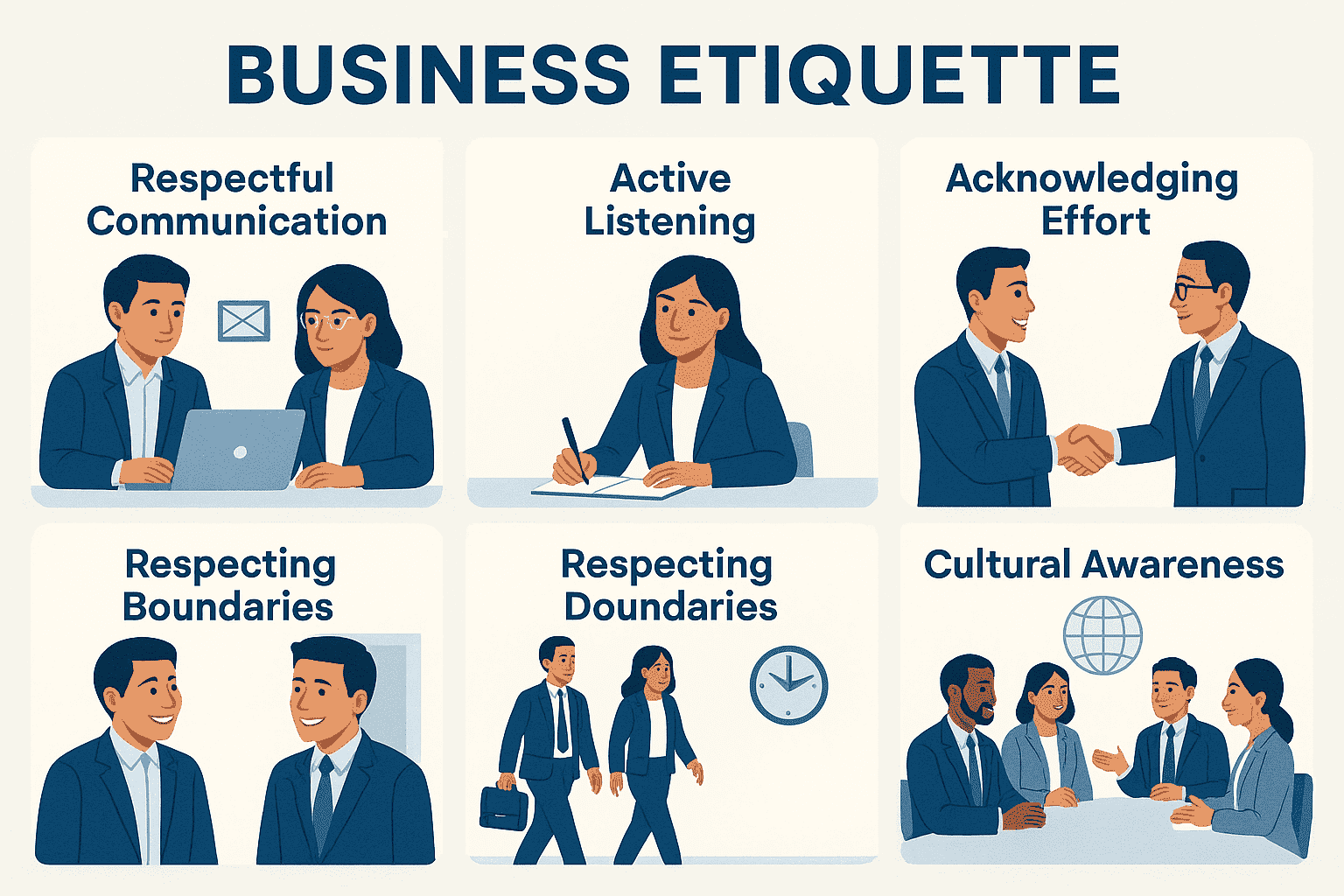Business Etiquette and Your Mental Well-Being

When people hear the phrase business etiquette, they often think of surface-level rules: how to dress in a professional setting, how to introduce yourself during meetings, or how to sign off politely in an email. While those details are certainly part of the picture, the deeper value of etiquette lies in how it shapes our relationships, our confidence, and even our mental health.
As a therapist, I have seen how workplace stress can weigh heavily on people’s emotional well-being. Deadlines, unclear expectations, or difficult interactions with colleagues often leave individuals feeling overwhelmed and undervalued. What many overlook is that practicing small habits of consideration—what we call business etiquette—can create a healthier, more supportive environment where both productivity and people thrive.
Why Etiquette Matters Beyond Politeness
At its core, etiquette is not about rigid rules. It is about respect. Respectful behavior makes people feel seen and appreciated. In a professional environment, this sense of acknowledgment reduces tension and fosters trust. When employees feel respected, they are more likely to communicate openly, share ideas without fear of judgment, and handle conflict in constructive ways.
For clients struggling with anxiety at work, learning simple skills of etiquette—such as active listening or giving feedback kindly—often provides a sense of control. Knowing how to navigate interactions makes them feel less vulnerable, especially in high-pressure situations. This shows that etiquette is not just about social polish; it is also about creating stability and predictability in daily interactions, which is deeply grounding for mental health.
Communication as a Foundation
One of the most important aspects of business etiquette is communication. The way we speak to each other shapes the tone of the entire workplace. A short, abrupt email can be interpreted as rude even when no offense was intended, while a thoughtful acknowledgment of someone’s effort can motivate them for days.
From a therapeutic perspective, this means communication is not simply about transferring information; it is about connection. When you choose words carefully, pay attention to body language, or pause to listen before responding, you send the message that the other person’s perspective matters. This kind of respectful dialogue builds stronger professional bonds and reduces the misunderstandings that often escalate into conflicts.
Good communication also benefits self-esteem. Clients frequently tell me they feel more confident when they know how to express themselves clearly and respectfully. They no longer worry about being misinterpreted, which reduces social anxiety and makes them more effective in leadership roles.

The Role of Listening
Listening is sometimes overlooked in discussions of professional courtesy, yet it is one of the most powerful tools we have in the workplace. When people feel truly heard, they are more likely to engage, collaborate, and contribute to solutions.
Active listening—maintaining eye contact, nodding, summarizing what the other person has said—signals empathy. It demonstrates that you are not just waiting for your turn to speak but are genuinely invested in understanding. This practice is central to therapy sessions, but it is equally valuable in business contexts.
The mental health benefits of listening go both ways. The speaker feels validated, while the listener cultivates patience and presence. Over time, these small habits build resilience and reduce the stress that comes from constant miscommunication.
Navigating Cultural Differences
In today’s interconnected world, workplaces often bring together people from diverse backgrounds. What is considered polite in one culture may feel abrupt or overly formal in another. Here again, professional courtesy offers guidance. By approaching colleagues with curiosity and openness, you create space for understanding rather than judgment.
For instance, in some cultures, direct eye contact shows confidence; in others, it may be considered disrespectful. Rather than assuming, taking the time to ask or observe shows respect and fosters inclusivity. This is not only good for workplace harmony but also for personal well-being. When people feel they can bring their authentic selves to work without fear of offending or being misunderstood, stress decreases, and satisfaction rises.
Etiquette as Self-Care
It may sound surprising, but practicing etiquette can be a form of self-care. By choosing professionalism and respect, you help shape a work environment that feels safer and more predictable. Stability is essential for reducing chronic stress.
Think of it this way: when meetings start on time, feedback is delivered kindly, and colleagues greet each other with basic courtesy, the brain does not need to remain on constant alert. That lowered sense of vigilance allows more energy for creativity, problem-solving, and building meaningful connections.
For people already managing mental health challenges such as anxiety or depression, these small reductions in stress can make a profound difference in daily well-being.

Putting Etiquette Into Practice
Here are a few practical ways to bring etiquette into your work life:
- Be mindful of tone. Reread emails before sending them to ensure they sound respectful rather than rushed.
- Acknowledge effort. A simple “thank you” or recognition of someone’s contribution fosters goodwill.
- Respect boundaries. Avoid unnecessary interruptions and honor working hours.
- Practice empathy. Consider how your words or actions may be received, especially during stressful projects.
- Keep learning. Stay open to feedback about cultural or generational differences in communication.
These steps may seem small, but over time, they create a ripple effect that benefits both individuals and organizations.
Closing Thoughts
While the word business etiquette might bring to mind formalities, its true value is much deeper. It is about respect, inclusivity, and care for the well-being of ourselves and others. By practicing mindful communication, active listening, cultural awareness, and professionalism, we create workplaces where people can thrive both emotionally and professionally.
For many of my clients, learning and applying these principles have eased workplace stress and strengthened their sense of self-worth. It is a reminder that etiquette is not just about doing what looks right—it is about creating an environment where everyone feels they belong.
Ready to Take the Next Step?
If you find yourself struggling with workplace stress, communication challenges, or the weight of responsibilities in your personal or professional life, you don’t have to go through it alone. Reaching out for support can be the first step toward feeling more balanced and confident.
I invite you to contact me if you’d like to talk about the challenges you’re facing —whether at work, at home, or in between. Together, we can explore strategies to reduce stress, build resilience, and create the sense of well-being you deserve.